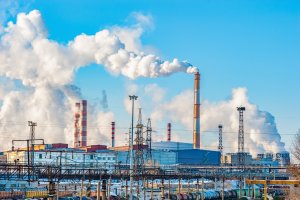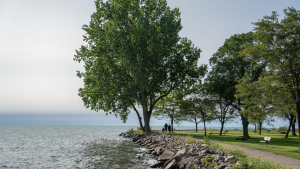Air Quality Awareness Week: How Green Spaces Help Clean Our Air
May 8, 2024
Steve Dishman, Park Interpreter
Air Quality Awareness Week takes place each May and helps the public better understand the causes of and solutions to poor air quality. This year, Air Quality Awareness Week is May 6-10, 2024.
What is air quality and how is it measured?
Air quality measures include everything from particulates (the solid pieces of air pollution that might include everything from pollen to solids in wildfire smoke) to greenhouse gases. Scientists examine air quality on an index running from 0-500. The lower the number, the cleaner the air. Air quality is impacted by natural and human-made causes. Poor air quality impacts people, wildlife, and even plants.
Outdoor air quality can worsen in the spring and summer months because warmer temperatures are associated with increases in ground-level ozone as well as natural pollens from plants. Additionally, the warm seasons in some areas are now drier seasons, increasing the number and severity of wildfires. Winds carry the smoke and impact air quality measures for hundreds of miles.
How do green spaces improve air quality?
With the temperatures rising, flowers blooming, and trees budding, there can be no better place to visit than your local Metropark. It can be a positive for mental health, certainly, but it’s a big positive for air quality.

As residents of southeastern Michigan, we know that our area has been industrialized from power companies to the automotive industry. The discharge of gases from industry can lead to problems with smog, such as increasing air temperatures, and respiratory problems for people. Smog is basically, surface-level ozone. Ozone(O3) is beneficial in our atmosphere to block dangerous UV rays from the sun. But on the surface, it can damage our respiratory tissues and pollute the air. To compound the problem, automobiles emit nitrogen dioxide (NO2), which combined with ozone, can be very detrimental to long-term health. It may seem grim, but this is where “green spaces” can help.
Urban and suburban areas have been very much involved in plotting green spaces, usually parks. Not only do parks provide recreation opportunities for millions, they can help offset the damage that air pollution does. Trees and plants utilize carbon dioxide (CO2) to grow. The planting of the right vegetation in our parks will help capture the hazardous gases, usually in the leaves of the plants. Transpiration is something else that helps. Transpiration is the evaporation of water from plants. When the air gathers water from plants, it helps to cool the temperatures and also reduce the effect of smog in the air.
The cooling actions of green spaces can help people and wildlife during hot spells, but also reduce the impacts of heat above cities and other urban areas. Trees and plants provide direct shade, but also deflect some of the sun’s rays so that the ground level doesn’t warm as much as bare pavement in a parking lot or street. Finally, the moisture given off through transpiration can also help reduce droughts and dry spells, thus reducing the potential for wildfire.

Community level action
Planting trees and other vegetation, especially where it reduces paved surfaces, can impact the air quality at home or in our parks. Not only are there mental, emotional, and aesthetic benefits to increased green space, our physical health can be improved, too.
In short, responsible urban and suburban developers across the world are noticing the positive impacts of planning for green spaces. The health benefits alone are supporting the argument that developing more land isn’t always the answer. We hope to see you out at the parks this spring and take a good deep breath of the air. And don’t forget to thank the trees!
Resources and further reading:
